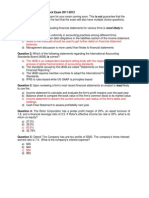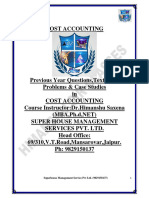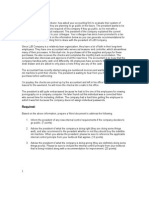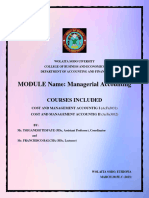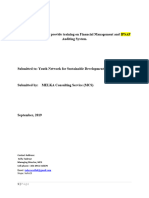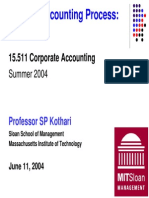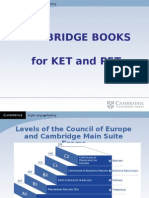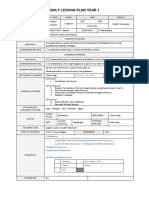0 ratings0% found this document useful (0 votes)
817 viewsUsing Role Play To Teach Internal Control
This document describes a role-playing exercise used to teach internal controls in an auditing course. Students are divided into audit teams and tasked with performing control testing procedures on the revenue cycle of an ice cream company. The exercise is conducted by having student teams interact with the instructor acting as the client. This allows students to actively practice control testing procedures rather than just learning about them. Student feedback indicated a high level of enjoyment and understanding from using this active learning approach compared to traditional lecture-based teaching of the material.
Uploaded by
aamritaaCopyright
© © All Rights Reserved
Available Formats
Download as DOC, PDF, TXT or read online on Scribd
0 ratings0% found this document useful (0 votes)
817 viewsUsing Role Play To Teach Internal Control
This document describes a role-playing exercise used to teach internal controls in an auditing course. Students are divided into audit teams and tasked with performing control testing procedures on the revenue cycle of an ice cream company. The exercise is conducted by having student teams interact with the instructor acting as the client. This allows students to actively practice control testing procedures rather than just learning about them. Student feedback indicated a high level of enjoyment and understanding from using this active learning approach compared to traditional lecture-based teaching of the material.
Uploaded by
aamritaaCopyright
© © All Rights Reserved
Available Formats
Download as DOC, PDF, TXT or read online on Scribd
You are on page 1/ 9
USING ROLE PLAY TO TEACH INTERNAL CONTROLS
IN A BASIC AUDITING COURSE
Sharon Cheuk
Universiti Malaysia Sabah, Malaysia (cscheuk@ums.edu.my)
ABSTRACT
The auditing of business oerating cycles is often taught using the te!tbook aroach, "hereby students are
resented "ith basic theory, follo"ed by an e!lanation and demonstration of relevant audit rocedures. This
instructional case describes a role laying e!ercise that has been successfully used at Universiti Malaysia Sabah
(UMS) to rovide students "ith hands#on e!erience in testing internal controls in a revenue cycle audit.
$lthough this activity involved relatively little formal lecture inut from staff, there "as a significant investment
of staff time in "riting the role#lay document and in organising and facilitating the role lay e!ercise. Students%
feedback "as largely encouraging in that a high level of en&oyment and understanding of the material "as
observed.
KEYWORDS
'ole lay, $udit, (nternal controls
INTRODUCTION
(nternal controls lay an imortant role in ho" the management of an organisation meets its
ste"ardshi resonsibilities. (nternal controls are imlemented in order to ensure the
effectiveness and efficiency of oerations, reliability and timeliness of financial reorting,
revention and detection of fraud and error and comliance "ith la"s and regulations
(Messier ) *oh, +,,-).
Students are usually taught to audit internal controls via a .sho" and tell% aroach, and
fre/uently do not understand the urose behind the audit rocedures. This role lay e!ercise
utilises an active learning strategy to increase students% understanding of the revenue cycle
and to be able to erform control testing rocedures related to the cycle. 'ole lay has been
defined by 0ardley#Mat"ie&c1uk (233-, .2) as .a "ay of constructing an aro!imation of a
4real life5 e!erience, but under 4controlled5 conditions to facilitate learning%. McMillan
(2336) highlighted the need for simulated audit cases and role laying scenarios that can be
used to hel students and recently#hired auditors to attain the skills and roficiencies of more
e!erienced auditors. (n the teaching of auditing, role lay has been used by 7anvrin (+,,8) in
the e!amination of internal control and fraud detection concets, and to a certain e!tent in a
roblem#based learning case in forensic auditing resented by 9urtschi (+,,8).
(n this e!ercise, students are led to articiate actively in the erformance of control testing,
rather than &ust being taught about them and given the relevant e!amles. (n the erformance
2
:roceedings of the +
nd
(nternational Conference of Teaching and ;earning ((CT; +,,3)
(<T( University College, Malaysia
of the said rocedures, students are rogressively led to /uestion the findings, interact "ith
the instructor (acting as the 4client5) accordingly, and, if needed, to further /uestion
subse/uent findings. $s such, learning is effected on a layer#by#layer basis, and students
discover rather than ac/uire the kno"ledge involved.
The advantage of using the role lay as a teaching aroach (as oosed to a real#life audit in
an organisation) is to avoid thro"ing students too much at the dee end. (n a role lay, the
instructor can control the learning environment. $nother advantage is that it involves minimal
ufront reading on the background of the comany, unlike a case study aroach. Students
are given a brief history of a comany (and the relevant financial and non#financial data) and
are then lunged straight into conducting the audit, audit rogramme in hand.
THE CASE
General Background of the Company
(ce Cream :aradise Sdn. *hd. is an ice#cream manufacturer "hich o"ns a factory in =ota
=inabalu, Sabah. (t sells ice#cream on a retail and a "holesale basis. >or retail, it has a sho
outlet "hich sells goods to "alk#in customers. >or "holesale, it sells ice#cream in tubs to
retail shos and suermarkets. (t also delivers its goods to customers by e!ress.
Exercise
This is a role#laying game. 0our class "ill be divided into audit teams comrising of no
more than 6 to ? eole each.
The task of each team is to erform testing of the internal controls ertaining to the revenue
cycle of (ce Cream :aradise, in accordance "ith the audit rogramme belo", and to record
do"n the findings obtained. 9uring the course of erforming the testing rocedures, each
team "ill be romted to re/uest for documents or records from the 4client5 and e!amine
them accordingly, and to make certain en/uiries of the 4client5.
Students should note that in erforming the rocedures, they should be "ary of any otential
misstatements (either error or fraud) in the data@documents@records and verbal resonses
given, and highlight them accordingly. (ndicators of misstatements may be as follo"sA (2)
verbal information or e!lanations given by 4client5 is inconsistent "ith the data@documents@
records handed out, and (+) data in a document is inconsistent "ith data in another document.
Students "ill be given documents only in resonse to secific re/uests ("ith reference to the
name of document and relevant time eriod the document ertains to).
The lecturer "ill act as the client "ith "hom each audit team deals. Bach team "ill meet u
"ith the client searately and ask any /uestion they can think of. Teams must maintain
rofessionalism and treat the 4client5 "ith resect, as they "ould in a real#life "orking
environment.
+
The follo"ing is an e!tract of the audit rogramme to be follo"ed by students. The "ords in
italics sho" "hat the students should have obtained, either from observation of the
documents obtained or from en/uiries made to the instructor@lecturer, as their audit findings.
Test Of Controls Revenue Transactions
Audit Objective Audit prcedure E!tr" #uide $r %tude&t%'Findings
Calidity
(to find out "hether
there are fictitious
sales, or incidences
"hereby sales is
recorded but goods
not shied@services
not erformed)
Test ? sales invoices and
look for the relevant
authorised sales order )
shiing document (bill
of lading).
D'efer $endi! $ for a
samle of sales invoice,
authorised sales order
and bill of ladingE
No exceptions noted.
Bill of lading should show references to
sales invoice.
$uthorisation
(to avoid incidences
"here goods are
shied@services
erformed for a
customer "ho is a
bad credit riskF to
avoid
shiments@services
erformed at
unauthorised rices
or on unauthorised
terms)
'evie" the client%s
rocedures for granting
credit to customers.
Yur (ecturer i% t)e c(ie&t* A%+ )er "but
t)i% ,"tter*
Lecturers response: When sales order <
RM4! is received! the order is passed
to the "inance Manager for credit
approval. #he "inance Manager will
review the custo$ers credit rating with the
co$pan%. &f it is positive! then credit
approval will 'e given. "or sales order
(RM4!! approval needs to 'e o'tained
fro$ the )eneral Manager.
B!amine sales orders for
evidence of credit
aroval.
D'efer to $endi! $
for authorised sales
orderE
U%e t)e %"(e% rder% -)ic) .u )"ve
"(re"d. bt"i&ed*
*ales orders are approved '% *ales
Manager +instead of "inance Manager,.
-ence! internal control has not 'een
co$plied with.
TEACHING NOTES
earning O!"ectives of the Case
The rimary ob&ective of this case is to increase students% understanding of internal controls
and to be able to test the controls accordingly.
$ secondary learning ob&ective is to sharen students% intervie"ing and communicational
skills. Ghen interacting "ith the instructor as a .client%, students "ould learn ho" to elicit
information efficiently and emloy critical listening skills. Ghen interacting "ith other
8
students in a team, students articiate in team "ork and sharen their interersonal,
team"ork and, in some cases, leadershi skills.
$nother ob&ective is to train u analytical, critical thinking and roblem solving skills. This is
effected "hen students try to e!ecute the audit rogramme. >or instance, they "ould need to
analyse and roblem#solve the information given to them, numerical or other"ise, and to
critically assess the ans"ers given by the .client%.
#rogramme$ Course and Class Background
The accounting rogramme at Universiti Malaysia Sabah (UMS) is a four#year honours
course, and auditing is one of the core sub&ects. Students take a basic auditing course in their
+
nd
year of study, follo"ed by an intermediate course in the immediate follo"ing semester.
$t the time of "riting, the basic auditing course had been conducted four times (and is
currently being conducted for the fifth time) by the author. The syllabus "as structured to
include H "eeks of lectures covering various toics such as audit lanning, audit samling,
materiality, audit evidence and documentation and internal controls. >rom the ninth "eek
on"ards, students learnt about auditing various business cycles. This e!ercise is usually
layed "hen covering the internal controls toic in general, or "hen teaching the internal
controls section of the revenue cycle. <o secific sub&ect matter needed to be deleted from
the course to accommodate this e!ercise.
This role lay e!ercise has been class#tested by the author in ? basic e!ternal auditing classes,
in consecutive semesters bet"een 7anuary +,,? I May +,,3, at Universiti Malaysia Sabah.
The total number of the students in the classes "ere --, -8, JH, -8 and -, resectively.
%mplementation of the Exercise
$s rearation before the role lay, students "ere encouraged to read the chaters on internal
controls and the revenue cycle in the te!tbook, "hich is, in this case, $uditing and $ssurance
Services in Malaysia (8rd ed.) (Messier ) *oh, +,,-).
*efore undertaking the e!ercise, students "ere given a short briefing session. They "ere also
reminded that they could clarify the oints they do not understand "ith the instructor at any
oint in time during the role lay. The instructor, in essence, "ears t"o hats during the entire
rocess facilitator and client I and s"itches to and fro as necessary.
'esources given to students include the follo"ing handoutsA (a) brief background of the case
comanyF and (b) audit rogramme. The instructor himself should be armed "ith the audit
rogramme, in "hich suggested solutions are incororated.
Time allocated for this is u to the discretion of the instructor, but as a rough guide, it should
be about 2 to 2.? hours. (deally, the room "here this e!ercise is run should have sufficient
sace for students to move around, as they "ill be "orking in grous and going to and fro
bet"een their desks and "here the instructor is. The instructor should also move around from
grou to grou to handle /uestions and to give hints, "here necessary. Since the students "ill
be "orking in grous, the room should be laid out in a "ay that facilitates discussion I for
instance, there should be grous of tables and chairs in different areas of the room.
6
Students can "ork on the audit rogramme in no articular se/uenceF ho"ever, the
rogramme is designed in such a "ay that erforming the rocedures in se/uence hels a
student learn in a more logical manner.
This e!ercise should be largely free#flo". Knce briefed, students should start reading the
audit rogramme and atteming the audit rocedures. The students should also make use of
the information rovided to them to hel them "hen making an analysis of the organisation,
be it the background of the organisation or the financial data. $ny organisation#related
/uestions should be directed to the 4client5. The goal of this e!ercise is to note do"n the
findings as the result of erforming the audit rocedures in the audit rogramme.
$t the end of the e!ercise, the instructor "ould call a sto to activities, and discuss the
ans"ers to the audit rogramme. The discussion should include the findings that the students
should have located, any indications of discreancies, the /ueries that students should have
made to the 4client5, and finally the reason@s for the variances in financial data.
#ro!lems Encountered during the %mplementation of Exercise and &uggested 'ays to
Overcome Them
Students not reviously e!osed to auditing role lay may need very detailed e!lanation as
to "hat is e!ected. Lo"ever, it is the author%s e!erience that students /uickly get into the
routine of analysing data, asking /uestions, obtaining ans"ers, and follo"ing u "ith more
/uestions for clarification or "hen the ans"ers do not sound feasible.
Students may e!erience information overload, esecially "hen faced "ith data that is
seemingly unarranged. Lo"ever, if they concentrate on comleting the audit rogramme
se/uentially, they should realise that the information given "ill be used in iecemeal fashion.
(n other "ords, they do not need to use all of the information at one go. (t is very imortant
that students understand this, other"ise it may form a sychological barrier to learning.
Ghen searating into grous, students tended to grou themselves into large grous of -#H
eole each, due to the desire to flock together "ith their friends. Ghile en&oyment "hen
erforming a class e!ercise is conducive to learning, this fre/uently leads to a lack of
disciline "ithin the grou, "hereby members are not censored "hen they do not erform.
Students also may get distracted easily by other (ersonal) toics during discussion. The
instructor must be strict in limiting the numbers of students in each grou I 8 to 6 members to
a grou "ould be /uite ideal. (n the author%s e!erience, the entire class numbered about J,
students. The author slit them into + classes (run at different times), of 8, students each, for
easier control. To revent students from flocking together "ith their friends, students could be
groued together via lot#dra"ing.
$s "ith all grou#based learning, the free#rider roblem may be revalent, "hereby students
do not articiate to the best of their abilities. This may be frustrating to the other grou
members, esecially in a time#constrained situation. This could be avoided by grou#member
rotation (7oyce, 2333). Students could also be re/uested to maintain a &ournal reflecting on
"hat they have learned, as advocated by Cooer (233H). Lere, students might identify events
that changed their ercetion about the analytical rocedures erformed, note do"n "hat
they did right (and "hat they did "rong), "hat "ere the situations faced and ho" they took
stes to rectify any roblems. Gith the benefit of hindsight, students "ould also note do"n
?
"hat they could have done better. *oth grou#member rotation and reflection &ournal
maintenance force students to be individually accountable for their o"n learning.
Feed!ack and Reaction from &tudents
$ ma&ority of the students have reacted favourably to this e!ercise. They felt that this gave
them e!osure and insight into the actual "orkings of an audit. Many of the students "ould
be erforming their internshi at audit firms during the semester holidays and "ere not
confident of being able to handle the tasks assigned to them. This lack of confidence "as due
largely to a lack of kno"ledge of the tye of "ork done at audit firms. Laving gone through
"hat they erceived "as an actual audit task erformed in firms, they felt better e/uied.
$ high level of en&oyment "as evident during the e!ercise, because it "as noted that students
"anted to finish the e!ercise rather than sto "hen the time "as u. (t "as also noted that
they aid close attention to the debriefing sessions and comared their ans"ers to the
suggested ans"ers. They also took note of "hat they missed out on. (t "ould be /uite safe to
say that they treated this as a game.
9uring the course of running this e!ercise, the author encountered a fe" students "ho reacted
unfavourably. These students referred assive and more structured learning, "here the
instructor elaborates on material from the te!tbook, and "ere e!am#oriented. (t is a national
re/uirement (in Malaysia) that $ccounting students are evaluated using a high "eighting of
"ritten e!aminations. These students "ere therefore more comfortable "ith the assing out of
lecture notes and ractice /uestions as these usually served as e!am rearation material. (n
the author%s course, this e!ercise "ould relace the entire traditional lecture. <o materials
"ould be given to the students other than case#related materials, as it "as e!ected that the
students "ould have read the assigned te!t readings.
(uantitative Evaluation of &tudents) *ttitudes to+ards the Role #lay Exercise
>ollo"ing the comletion of *asic $uditing course in May +,,3, a /uestionnaire survey "as
undertaken to determine student attitudes to"ards the role lay e!ercise. The survey "as
tailored to /uantitatively measure the students% oinion of the role lay e!ercise, and their
assessment of certain skills and cometencies gained. The /uestionnaire allo"ed students to
remain anonymous by not re/uesting for their identity, and e!licitly stated that students
"ould not be negatively enalised in their course marks if unfavourable ans"ers "ere given.
$ five#oint ;ikert scale "as emloyed to measure resonses to 2J statements, "ith a score
of ? indicating that the student strongly agrees "ith the statement, and a score of 2 indicating
that the student strongly disagrees. (Scores of 6, 8 and + refer to 4$gree5, 4<eutral5 and
49isagree5 resectively.) >or each of the /uestions osed, mean scores "ere high and fell
"ithin the +.-3 I 6.2? range. The survey findings revealed a generally suortive and
ositive attitude to"ards the e!ercise. Students recorded a high level of en&oyment from the
role lay e!ercise and referred having e!ercises to normal lectures. They thought that the
e!ercise "as realistic and heled them better understand the uroses and benefits of an
audit. They also generally felt that the e!ercise "as of value to them as a student and as a
future auditor, and heled them gain skills that could be used in other sub&ects. Lo"ever, they
felt that the role lay e!ercise highlighted the difficulty of a real#life audit assignment and
generally did not feel that the e!ercise "as easy to erform. Gith resect to skills and
J
cometencies gained, students generally agreed that their communicational, client
intervie"ing, critical thinking, roblem#solving and analytical skills have imroved. The
detailed results to the survey are sho"n in Table 2 in $endi! *.
(t should be noted that the student assessment, in general, has its limitations. $lthough it is
easy to administer, score and summarise, it is mainly a measure of student satisfaction "ith
the course@ro&ect (Smith, +,,6). (n this case, it is also a measure of students% ercetion of
the skills that they have achieved. Bven though the actual skills achieved by the students "ere
not measured by this, its merit, arguably, is in being an indicator of student confidence level
after the course@ro&ect.
CONCLUSION
This aer described a role lay e!ercise that has been successfully used at Universiti
Malaysia Sabah (UMS) to rovide students "ith hands#on e!erience in conducting
analytical rocedures in a revenue cycle audit. (t rovides a good e!amle of ho" auditing
can be brought to life for students. Students% feedback "as largely encouraging in that a high
level of en&oyment and understanding of the material "as observed. The results suggested
that the role lay e!ercise can lay a significant role in the teaching@learning rocess of the
auditing sub&ect.
RE/ERENCES
Cooer, 9. 9., 233H. 'eading, "riting and reflection. New .irections for #eaching and
Learning! -8, 6-#?J.
9urtschi, C., +,,8. The Tallahassee *eanCountersA $ :roblem#*ased ;earning Case in
>orensic $uditing. &ssues in /ccounting 0ducation! 2H(+), 28-#2-8.
7anvrin, 9.7., +,,8. St. :atrick ComanyA Using 'ole :lay to B!amine (nternal Control and
>raud 9etection Concets. 1ournal of &nfor$ation *%ste$s! 2-(+), .2-#83.
7oyce, G.*., 2333. Kn the >ree#'ider :roblem in Cooerative ;earning. 1ournal of
0ducation for Business! -6(?), .+-2#+-6.
McMillan, 7.7., 2336. (dentifying and closing gas in &udgmental and behavior of auditing
students and staff auditors. &ssues in /ccounting 0ducation +"all,! 3! +H+#8,,.
Messier, G.>. ) *oh, M., +,,-. /uditing and /ssurance *ervices in Mala%sia. 8rd ed.
MalaysiaA McMra"#Lill.
Smith, M.S. +,,6. $ssessment strategiesA "hat is being measured in student course
evaluationsN /ccounting 0ducation! 28(2), 8#+H.
0ardley#Mat"ie&c1uk, =.M., 233-. Role 2la%: #heor% 3 2ractice. ;ondon, U=A Sage
:ublications.
-
APPENDI0 A
I&vice
ICE1CREA2 PARADISE SDN* BHD*
345 6"("& Li&t"%7 Pe&",p"&#
8549: Kt" Ki&"b"(u7 S"b")7 2ALAYSIA
Te(; 48813<= 9857 /"!; 48813<= 954
(nvoice <o. +8H3,2
9ateA ?@+@+,,H
S)ip t; Tong Ling Suermarkets Sdn. *hd. Bi(( t; Tong Ling Suermarkets Sdn. *hd.
OrderID Cu%t,er ID S"(e%per%& Order D"te Re> D"te De(iver. D"te De(iver ?i"
2,6H, TL(<M S$ 6@+@+,,H -@+@+,,H J@+@+,,H $:C(
PrductID Prduct N",e @u"&tit. U&it Price Di%cu&t Price
6- Chocolate tub ice#cream (? litres) ?,, O6?.,, ,.,,P O++,?,,.,,
/rei#)t; OJ-?.,,
Tt"(; O+8,2-?.,,
:ayment due dateA 8, days from the date of this invoice
Checked byA
Nora Baharuddin (Signature)
<K'$ *$L$'U99(<, S$;BS BQBCUT(CB
$uthorised byA
Li$ #ei4 Wee (Signature)
;(M TB(= GBB, S$;BS M$<$MB'
S"(e% Order
Order Nu,berA SK2+,2
D"teA ,6@,+@+,,H
S(d tA
Tong Ling Suermarkets Sdn. *hd.
?? 7alan Maya
HH,,, =ota =inabalu
Sabah
De(iver TA
Tong Ling Suermarkets Sdn. *hd.
?? 7alan Maya
HH,,, =ota =inabalu
Sabah
S"(e%per%&A S$
P"rticu("r%; R2
?,, units Chocolate flavour ?#litre tub ice#cream ++,?,,.,,
(?,, ! 'M6?@unit)
TKT$; ++,?,,.,,
Checked byA
Nora Baharuddin (Signature)
<K'$ *$L$'U99(<, S$;BS BQBCUT(CB
$uthorised byA
li$ #ei4 Wee (Signature)
;(M TB(= GBB, S$;BS M$<$MB'
Bi(( O$ L"di&#
C$''(B'A
$:C( 9(ST'(*UTK'S
2-H 7$;$< T(M$
H3,-- =KT$ =(<$*$;U
S$*$L
;K$9 R
2338
*(;; K> ;$9(<M R
+,,,2
9$TB
J@+@+,,H
9B;(CB' TKA
Tong Ling Suermarkets Sdn. *hd.
?? 7alan Maya
HH,,, =ota =inabalu, Sabah
SU$<T(T0@C$SBS@U<(TS :$'T(CU;$'S GB(MLT
?,, Chocolate flavour ?#litre tub ice#cream +,?,, kg
$uthorised byA
Nasril /h$ad (Signature)
Shiing 9eartment Manager
($:C( 9(ST'(*UTK'S)
H
APPENDI0 B
T"b(e A* Re%u(t% $ Stude&t Surve.
St"te,e&t b. Stude&t 2e"& %cre
OPINION O/ THE ROLE PLAY E0ERCISE
2 ( en&oyed the role#lay e!ercise. 6.2?
+ The role#lay e!ercise "ere realistic. 6.,,
8
The role#lay e!ercise heled me to better understand the uroses and
benefits of an audit.
6.,6
6
$s a result of the role#lay e!ercise, ( feel confident that ( can erform
an audit in a real#"orld situation.
8.-?
? The role#lay e!ercise make me feel that a real#life audit is difficult. 6.,H
J The role#lay e!ercise "ere of value to me as a student. 8.3J
- The role#lay e!ercise "ere of value to me as a future auditor. 6.,,
H
( feel that the role#lay e!ercise hel me gain skills that can be used in
my other sub&ects.
6.,6
3 ( refer role#lay e!ercises to lectures. 8.-?
2,
( feel that role#lay e!ercise do not reare me "ell enough to do the
final e!ams.
+.3J
22 ( found the role#lay e!ercise easy to do. +.-3
SKILLS AND CO2PETENCIES GAINED
2
$fter the role#lay e!ercise, ( feel that my communication skills have
imroved.
8.?H
+
$fter the role#lay e!ercise, ( feel that my client intervie"ing skills have
imroved.
8.?,
8
$fter the role#lay e!ercise, ( feel that my critical thinking skills have
imroved.
8.-8
6
$fter the role#lay e!ercise, ( feel that my roblem#solving skills have
imroved.
8.J?
?
$fter the role#lay e!ercise, ( feel that my analytical skills have
imroved.
8.J3
3
You might also like
- Full Download Test Bank For Operations Management: Creating Value Along The Supply Chain, 2nd Canadian Edition, Roberta S. Russell, Bernard W. Taylor Tiffany Bayley Ignacio Castillo PDF100% (3)Full Download Test Bank For Operations Management: Creating Value Along The Supply Chain, 2nd Canadian Edition, Roberta S. Russell, Bernard W. Taylor Tiffany Bayley Ignacio Castillo PDF55 pages
- Ch2-Analyzing Financial Statements and Cashflows CFIN7No ratings yetCh2-Analyzing Financial Statements and Cashflows CFIN761 pages
- Compliance Guidelines Approved Final PrefaceNo ratings yetCompliance Guidelines Approved Final Preface40 pages
- The Concept of Business Environment, Significance and67% (9)The Concept of Business Environment, Significance and27 pages
- Introduction To Internal Control SystemNo ratings yetIntroduction To Internal Control System35 pages
- Business Failure Prediction 18 Sept 2010No ratings yetBusiness Failure Prediction 18 Sept 201041 pages
- Lecture Note#7 - Establishing An Effective Internal Control EnvironmentNo ratings yetLecture Note#7 - Establishing An Effective Internal Control Environment6 pages
- 2. Partnership - Division of Profits and LossesNo ratings yet2. Partnership - Division of Profits and Losses6 pages
- LESSON 2 BRANCHES OF ACCOUNTING Lecture Lesson 2No ratings yetLESSON 2 BRANCHES OF ACCOUNTING Lecture Lesson 23 pages
- Group Audits: Group Audit Assignments - 20% of Your Total GradeNo ratings yetGroup Audits: Group Audit Assignments - 20% of Your Total Grade2 pages
- Examination Prep Guide: Certified Treasury ProfessionalNo ratings yetExamination Prep Guide: Certified Treasury Professional24 pages
- Cost Accounting Book of 3rd Sem Mba at Bec Doms100% (1)Cost Accounting Book of 3rd Sem Mba at Bec Doms174 pages
- 1 Auditing Standards, Statements and Guidance Notes - An Overview PDFNo ratings yet1 Auditing Standards, Statements and Guidance Notes - An Overview PDF24 pages
- Test Bank For Auditing An InternationalNo ratings yetTest Bank For Auditing An International17 pages
- Strategic Management:: Creating Competitive AdvantagesNo ratings yetStrategic Management:: Creating Competitive Advantages108 pages
- Motivation: A Study On Employee MotivationNo ratings yetMotivation: A Study On Employee Motivation8 pages
- 020-435-Icq - Registration Government AgenciesNo ratings yet020-435-Icq - Registration Government Agencies21 pages
- 2HBO+ +Models+of+Organizational+Behavior+No ratings yet2HBO+ +Models+of+Organizational+Behavior+12 pages
- Impact of Accounting Information Systems On OrganizationalNo ratings yetImpact of Accounting Information Systems On Organizational5 pages
- Module 1 - Introduction To Business Policy & StrategyNo ratings yetModule 1 - Introduction To Business Policy & Strategy34 pages
- Auditing in Cis: President Ramon Magsaysay State University College of Accountancy and Business Administration100% (2)Auditing in Cis: President Ramon Magsaysay State University College of Accountancy and Business Administration13 pages
- 04 The Full Syllabus - Management Level Continued: Paper F2 Assessment StrategyNo ratings yet04 The Full Syllabus - Management Level Continued: Paper F2 Assessment Strategy3 pages
- Implementation Guide 2120: Standard 2120 - Risk ManagementNo ratings yetImplementation Guide 2120: Standard 2120 - Risk Management5 pages
- Technical Proposal To Provide Finacial Training For YNSD - YCI Project Finacial Staffs100% (1)Technical Proposal To Provide Finacial Training For YNSD - YCI Project Finacial Staffs5 pages
- The Effect of Motivational Tools On Employees MoralsNo ratings yetThe Effect of Motivational Tools On Employees Morals17 pages
- Instructional Case For Auditing Students: Understanding Internal Controls and Assessing Control RiskNo ratings yetInstructional Case For Auditing Students: Understanding Internal Controls and Assessing Control Risk23 pages
- Addressing The Proficiency Gap in Maritime Training Kalyan Chatterjea EMAS Training Academy & Simulation CentreNo ratings yetAddressing The Proficiency Gap in Maritime Training Kalyan Chatterjea EMAS Training Academy & Simulation Centre13 pages
- Report On Training Need Assessment of Square PharmaceuticalsNo ratings yetReport On Training Need Assessment of Square Pharmaceuticals33 pages
- Communication of Offer, Acceptance and Revocation Made Through Post (Letter or Telegram)No ratings yetCommunication of Offer, Acceptance and Revocation Made Through Post (Letter or Telegram)6 pages
- From The Data Given Below Calculate Labour Cost VarianceNo ratings yetFrom The Data Given Below Calculate Labour Cost Variance1 page
- Working With Dairy Businesses in Challenging TimesNo ratings yetWorking With Dairy Businesses in Challenging Times49 pages
- Daily Lesson Plan in Media and Information Literacy Tarzan 12 September 24, 2019 Media and Information Literacy 2No ratings yetDaily Lesson Plan in Media and Information Literacy Tarzan 12 September 24, 2019 Media and Information Literacy 23 pages
- Gates Were Left Open For Over A Year: The Great Fireworks Let DownNo ratings yetGates Were Left Open For Over A Year: The Great Fireworks Let Down24 pages
- Reading For Information Motivating Learners To Read EfficientlyNo ratings yetReading For Information Motivating Learners To Read Efficiently3 pages
- Summative Evaluation Form: Missouri'S Educator Evaluation SystemNo ratings yetSummative Evaluation Form: Missouri'S Educator Evaluation System4 pages
- 6th NUSP Luzonwide Student Leaders Congress & Student Trustees & Regents Federation Luzon Convention InvitationNo ratings yet6th NUSP Luzonwide Student Leaders Congress & Student Trustees & Regents Federation Luzon Convention Invitation6 pages
- Reading, Writing and Listening Test: Subject: English 11th FormNo ratings yetReading, Writing and Listening Test: Subject: English 11th Form5 pages
- Full Download Test Bank For Operations Management: Creating Value Along The Supply Chain, 2nd Canadian Edition, Roberta S. Russell, Bernard W. Taylor Tiffany Bayley Ignacio Castillo PDFFull Download Test Bank For Operations Management: Creating Value Along The Supply Chain, 2nd Canadian Edition, Roberta S. Russell, Bernard W. Taylor Tiffany Bayley Ignacio Castillo PDF
- Ch2-Analyzing Financial Statements and Cashflows CFIN7Ch2-Analyzing Financial Statements and Cashflows CFIN7
- The Concept of Business Environment, Significance andThe Concept of Business Environment, Significance and
- Lecture Note#7 - Establishing An Effective Internal Control EnvironmentLecture Note#7 - Establishing An Effective Internal Control Environment
- Group Audits: Group Audit Assignments - 20% of Your Total GradeGroup Audits: Group Audit Assignments - 20% of Your Total Grade
- Examination Prep Guide: Certified Treasury ProfessionalExamination Prep Guide: Certified Treasury Professional
- 1 Auditing Standards, Statements and Guidance Notes - An Overview PDF1 Auditing Standards, Statements and Guidance Notes - An Overview PDF
- Strategic Management:: Creating Competitive AdvantagesStrategic Management:: Creating Competitive Advantages
- Impact of Accounting Information Systems On OrganizationalImpact of Accounting Information Systems On Organizational
- Module 1 - Introduction To Business Policy & StrategyModule 1 - Introduction To Business Policy & Strategy
- Auditing in Cis: President Ramon Magsaysay State University College of Accountancy and Business AdministrationAuditing in Cis: President Ramon Magsaysay State University College of Accountancy and Business Administration
- 04 The Full Syllabus - Management Level Continued: Paper F2 Assessment Strategy04 The Full Syllabus - Management Level Continued: Paper F2 Assessment Strategy
- Implementation Guide 2120: Standard 2120 - Risk ManagementImplementation Guide 2120: Standard 2120 - Risk Management
- Technical Proposal To Provide Finacial Training For YNSD - YCI Project Finacial StaffsTechnical Proposal To Provide Finacial Training For YNSD - YCI Project Finacial Staffs
- The Effect of Motivational Tools On Employees MoralsThe Effect of Motivational Tools On Employees Morals
- Instructional Case For Auditing Students: Understanding Internal Controls and Assessing Control RiskInstructional Case For Auditing Students: Understanding Internal Controls and Assessing Control Risk
- Addressing The Proficiency Gap in Maritime Training Kalyan Chatterjea EMAS Training Academy & Simulation CentreAddressing The Proficiency Gap in Maritime Training Kalyan Chatterjea EMAS Training Academy & Simulation Centre
- Report On Training Need Assessment of Square PharmaceuticalsReport On Training Need Assessment of Square Pharmaceuticals
- Communication of Offer, Acceptance and Revocation Made Through Post (Letter or Telegram)Communication of Offer, Acceptance and Revocation Made Through Post (Letter or Telegram)
- From The Data Given Below Calculate Labour Cost VarianceFrom The Data Given Below Calculate Labour Cost Variance
- Working With Dairy Businesses in Challenging TimesWorking With Dairy Businesses in Challenging Times
- Daily Lesson Plan in Media and Information Literacy Tarzan 12 September 24, 2019 Media and Information Literacy 2Daily Lesson Plan in Media and Information Literacy Tarzan 12 September 24, 2019 Media and Information Literacy 2
- Gates Were Left Open For Over A Year: The Great Fireworks Let DownGates Were Left Open For Over A Year: The Great Fireworks Let Down
- Reading For Information Motivating Learners To Read EfficientlyReading For Information Motivating Learners To Read Efficiently
- Summative Evaluation Form: Missouri'S Educator Evaluation SystemSummative Evaluation Form: Missouri'S Educator Evaluation System
- 6th NUSP Luzonwide Student Leaders Congress & Student Trustees & Regents Federation Luzon Convention Invitation6th NUSP Luzonwide Student Leaders Congress & Student Trustees & Regents Federation Luzon Convention Invitation
- Reading, Writing and Listening Test: Subject: English 11th FormReading, Writing and Listening Test: Subject: English 11th Form



























